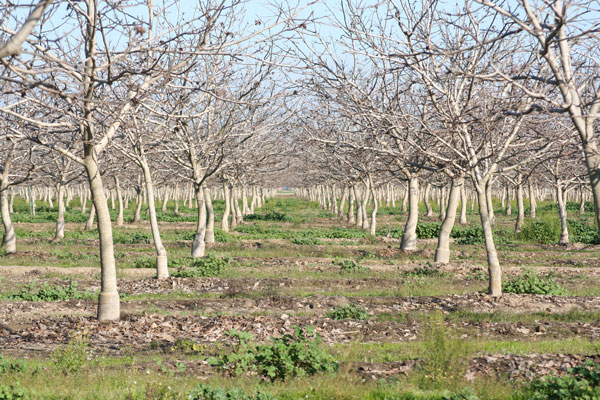
For a while early last November, it appeared that the market for the 2014 crop was thumbing its nose at basic economic laws.
Responding to continued strong demand, walnut prices had reached historic highs.
Prices of California’s three major varieties – Chandler, Howard and Tulare – ranged from about $2.00 to $2.10 per pound (in-shell), depending on quality.
On top of that, carry-over of 2013 crop walnuts was very low and there were concerns about a possible short-fall in 2014 production due to drought. Consequently, buyers, who had been caught short of product in the past few years and were anxious to secure supplies of the new crop early, bid up prices, explains Ron Martella, Stanislaus County walnut grower and processor.
At the same time, California’s growers were completing what looked to be their largest harvest ever.
Despite the need for a big crop to fill the nearly-empty market pipeline and the encouraging early sales of the new crop, Martella, who’s been farming walnuts for the past five decades, was cautioning that the marketing season was far from over. “With no more than about half the crop sold by now,” he said back then, “there are a lot more nuts to be sold.”
As it turned out, growers produced many more nuts to sell than he and just about every other observer were expecting. The 2014 Walnut Objective Survey, released by the USDA’s National Agricultural Statistics Service in early September predicted a record large crop – 545,000 tons (in-shell). However, by early January, receipts reported by processors were putting total 2014 production in the neighborhood of 561,000 tons.
While only about 3 percent more than projected, it has the potential to change things in the market. “Add another 15,000 tons or so to an already heavy crop, and it could have a significant impact on walnut prices,” says Martella. He’s a partner in the family-owned Ronald Martella Farms, which grows 800 acres of walnuts, and Grower Direct Nut Co., Inc., which buys, processes and sells walnuts.
However, another development is likely to have an even bigger impact on walnut prices – the nearly 21 percent drop in in-shell export sales along with a similar decline in domestic demand during the first quarter of the 2014-15 marketing season, as reported by the California Walnut Commission.
Want the latest agricultural news each day? Click here for the Western Farm Press Daily e-mail newsletter.
Much of the fall-off in exports of California’s 2014 walnut crop during the three-month period reflects a nearly 50 percent decline in shipments to Hong Kong, considered part of the big Chinese market.
“China harvested a record large walnut crop this past season and bought other walnuts from Eastern Europe,” Martella says.
The high prices of California walnuts combined with a U.S. dollar that has strengthened significantly in Canada , Europe, Japan and other markets has also contributed to the reduction in export sales, he says.
Other countries reducing their purchases of California in-shell walnuts during this time included major buyers, like Italy and Turkey, and such smaller customers as Australia, Brazil, Germany and Thailand. Greece, Jordan and Turkey were among countries, which bought California in-shell walnuts in the first three months of the 2013 crop marketing year, who purchased none in the same period this marketing season.
Meanwhile, during this time exports of shelled California walnuts rose almost 5 percent even as domestic purchases first fell by about 6 percent.
Despite the record tonnage harvested last fall by California’s walnut growers, Martella expects total meat yields – the ratio of kernel weight to total nut weight – to be down from average levels.
“We had more quality problems than normal,” he says. “The proportion of darker and shriveled meats was higher than usual. Part of the reason may be due to stress on the trees from the heavy crop and, perhaps, several days of hot weather close to harvest.”
Also, at least in his area of the state, walnuts suffered higher levels of navel orangeworm damage. Martella attributes that to an extra flight of the moths around the middle of October. Such timing can prohibit the use of pesticides, if the number of days between treatment and harvest exceed the required pre-harvest-interval period.
The combination of off-grade, shriveled and damaged nuts reduced meat yields by a point or two, he reports. For example, meat yields for Chandlers, which normally may have averaged 46 percent to 47 percent, slipped to around 45 percent. Meat yields on Howards and Tulares this season were around 51 percent, compared to a more-typical 52 percent.
Since the end of harvest, prices of 2014 walnuts have moved down. “We’ll have a better idea of how these recent developments in the market will affect prices in the next two or three months, based on sales between now and then,” Martella says.
He looks for a reversal in the seasonal price trends of the past six years, when prices continued to rise as the marketing year, which ends Aug. 31, progressed. “By the end of this marketing season, prices probably won’t be as high as expected at the start of the 2014 harvest,” Martella says. “I don’t look for a disaster, as in 2008-09 when prices to growers fell from around $1.50 per pound (in-shell) when the harvest began to 70 to 80 cents per pound by the following summer.
“Prices for this year’s crop should remain at a good level. Overall, things are still pretty good in the walnut industry.”
About the Author(s)
You May Also Like




